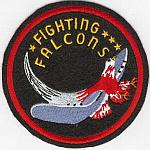James E. Swett
James Elms Swett (June 15, 1920 – January 18, 2009) was a United States Marine Corps fighter pilot and flying ace during World War II.[1] He was awarded the United States' highest military decoration, the Medal of Honor, for actions while a division flight leader in VMF-221 over Guadalcanal on April 7, 1943.He continued his advanced flight training, first at Quantico, Virginia, then at Lake Michigan, became carrier qualified aboard the USS Wolverine, and finally received his wings at San Diego, California.On April 7, 1943, on his first combat mission, Swett both became an ace and acted with such "conspicuous gallantry and intrepidity at the risk of his life above and beyond the call of duty" that he was awarded the Medal of Honor.Landing to refuel, the four-plane division of Grumman F4F Wildcats he was leading was scrambled after other aircraft reported 150 planes approaching Ironbottom Sound, and intercepted a large formation of Japanese Aichi D3A dive bombers (Allied code name: "Val") attacking Tulagi harbor.Wounded, he decided to ditch his damaged fighter off the coast of Florida Island, after it became clear that his oil cooler had been hit and he would not make it back to base.Now carrier-qualified and assigned to the USS Bunker Hill, Swett flew two strikes over Japan and then supported the landings at Iwo Jima and the operations on Okinawa.After the onset of the Korean War his squadron was deployed to Korea, but he was left behind because the Navy thought putting a Medal of Honor recipient in combat was too risky.Swett moved to Trinity Center, California, in his retirement and became a frequent speaker at schools, where he shared his strong feelings about the values of respect and responsibility.



Seattle, WashingtonRedding, CaliforniaIgo, CaliforniaUnited States of AmericaUnited States NavyUnited States Marine CorpsColonelVMF-221VMF-141World War IIBattle of GuadalcanalBattle of Iwo JimaBattle of OkinawaMedal of HonorDistinguished Flying CrossPurple HeartAir Medalflying aceGuadalcanalDistinguished Flying CrossesAir MedalsSan Mateo High SchoolSan Mateo, CaliforniaCollege of San MateoU.S. Naval ReserveNAS Corpus ChristiQuantico, VirginiaUSS WolverineSan Diego, CaliforniaSouthwest PacificHenderson Fieldcombat air patrolRussell IslandsGrumman F4F WildcatsIronbottom SoundJapaneseAichi D3Adive bombersTulagiFlorida Islandace on his first combat missionMarc MitscherVought F4U CorsaircaptainMitsubishi G4MMitsubishi A6M ZeroNew Georgiacoast watcher'sBougainvilleKawasaki Ki-61San FranciscoSan DiegoNAS Santa BarbaraCaliforniaUSS Bunker HillIwo JimaOkinawaYokosuka D4YkamikazeMCAS El ToroOperation OlympicNAS AlamedaKorean WarTrinity Center, CaliforniaPorscheThe History ChannelDogfightsNaval Aviator Badge5⁄16" Gold StarCombat Action RibbonNavy and Marine Corps Presidential Unit Citation3⁄16" Bronze StarsNavy Unit CommendationAmerican Defense Service MedalAmerican Campaign MedalAsiatic-Pacific Campaign MedalWorld War II Victory MedalArmed Forces Reserve Medalhourglass deviceSolomon IslandsUnited States Naval ServiceFRANKLIN D. ROOSEVELTList of Medal of Honor recipientsGeorge C. AxtellJefferson J. DeBlancArchie G. DonahueJeremiah J. O'KeefeJohn L. SmithWayback MachineEdward H. SimsInternet Movie Databasepublic domain materialFind a Graveflying acesRichard BongThomas McGuireDavid McCampbellGabby GabreskiGregory BoyingtonRobert S. JohnsonCharles H. MacDonaldGeorge PreddyJoe FossRobert M. HansonJohn C. MeyerCecil E. HarrisEugene A. ValenciaLance C. WadeDavid C. SchillingGerald R. JohnsonNeel E. KearbyJay T. RobbinsDominic Salvatore GentileFred J. ChristensenRay Shuey WetmoreJohn J. VollKenneth A. WalshWalker MahurinDonald N. AldrichThomas J. Lynch Robert B. WestbrookGlenn E. DuncanPatrick D. FlemingCornelius N. NooyJohn Lucian SmithAlexander Vraciu